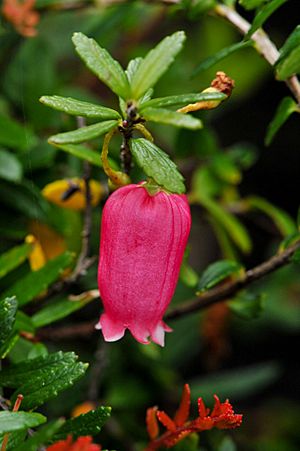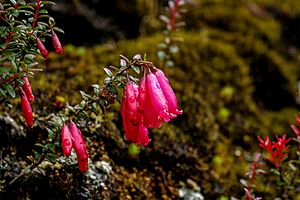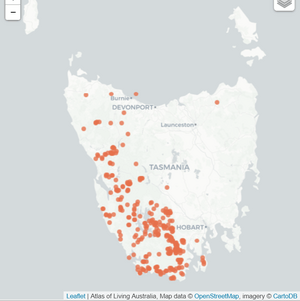Prionotes facts for kids
Quick facts for kids Prionotes |
|
|---|---|
 |
|
| Flower of Prionotes cerinthoides | |
| Conservation status | |
| Scientific classification | |
| Genus: |
Prionotes
|
| Species: |
cerinthoides
|
| Synonyms | |
|
|
Prionotes is a unique group of flowering plants found only in Tasmania, Australia. It has just one species, called Prionotes cerinthoides. People often call it the climbing heath. This plant is usually found in very wet, untouched areas. It can grow as a climber in temperate rainforests or as a small, sprawling bush in the mountains.
What it Looks Like
The climbing heath has a thin, wire-like stem that can grow about 1 meter (3 feet) long. Its leaves are a shiny, deep green. They are about 0.8 to 2 centimeters (0.3 to 0.8 inches) long. The leaves are shaped like an oval and have slightly toothed edges. They grow close together on the stem.
The flowers are a deep pink color and shaped like a bell. They are tubular, meaning they look like a tube. Each flower has 5 petals and can be up to 2.5 centimeters (1 inch) long. They are about 1 to 1.2 centimeters (0.4 to 0.5 inches) wide and get narrower at the opening. These flowers hang downwards and often grow in clusters. You can usually see them bloom in summer and autumn.
After the flowers, the plant produces a woody fruit. This fruit is a capsule that opens up into 5 parts. Each part holds many tiny seeds. P. cerinthoides can pollinate itself, and birds help spread its pollen.
Where it Lives
The plant family Ericaceae includes heaths and heathers. This family is found in many parts of the world, especially Europe and South Africa. It includes popular garden plants like Erica, Rhododendron, and Pieris.
Prionotes belongs to a special group within the Ericaceae family called Epacridoideae. This group was once thought to be a separate family. Prionotes has only one species, P. cerinthoides, which is found only in Tasmania.
You can find Prionotes cerinthoides in temperate rainforests. It also grows in high-altitude areas like subalpine and alpine plant communities in Tasmania, Australia.
This plant is a slender, long-lasting shrub. It can climb up tree trunks, especially those of the Nothofagus cunninghamii tree. Prionotes cerinthoides is common in the rainforests of western and southwestern Tasmania. It also grows in mountain areas and alpine plants. This species grows best in slightly acidic soil (pH 4-5). It needs a cool, moist, and shady spot to thrive.
Some people think this plant is a link between two heath families: the Epacridaceae (from the Southern Hemisphere) and the Ericaceae (from the Northern Hemisphere). The closest plant relative to Tasmania’s climbing heath lives in the rainforests of Chile.
How it Reproduces
The reproduction of Prionotes cerinthoides relies a lot on a native bird called the eastern spinebill (Acanthorhynchus tenuirostris). The plant's nectar and pollen are sticky. This means Prionotes cerinthoides cannot be pollinated by wind. Also, most bees find it hard to reach the pollen because of the special shape of the flower's opening.
Luckily, Prionotes cerinthoides is well protected in the Tasmanian Wilderness World Heritage Area and other national parks in Tasmania. This helps keep its habitat safe. The eastern spinebill, which helps the plant reproduce, is also found in many places.




